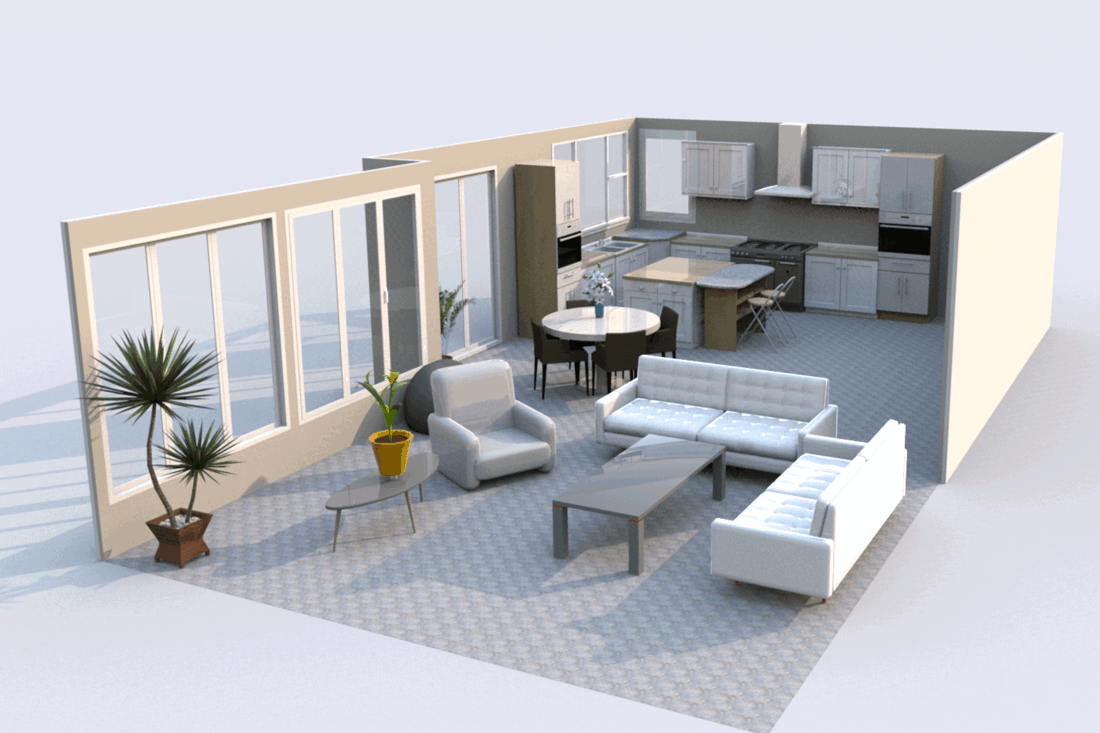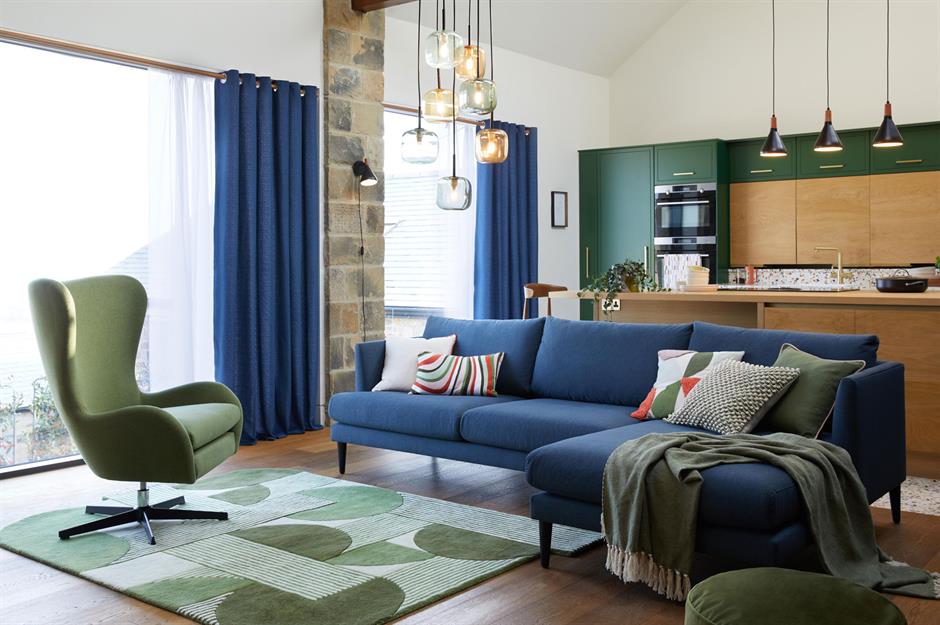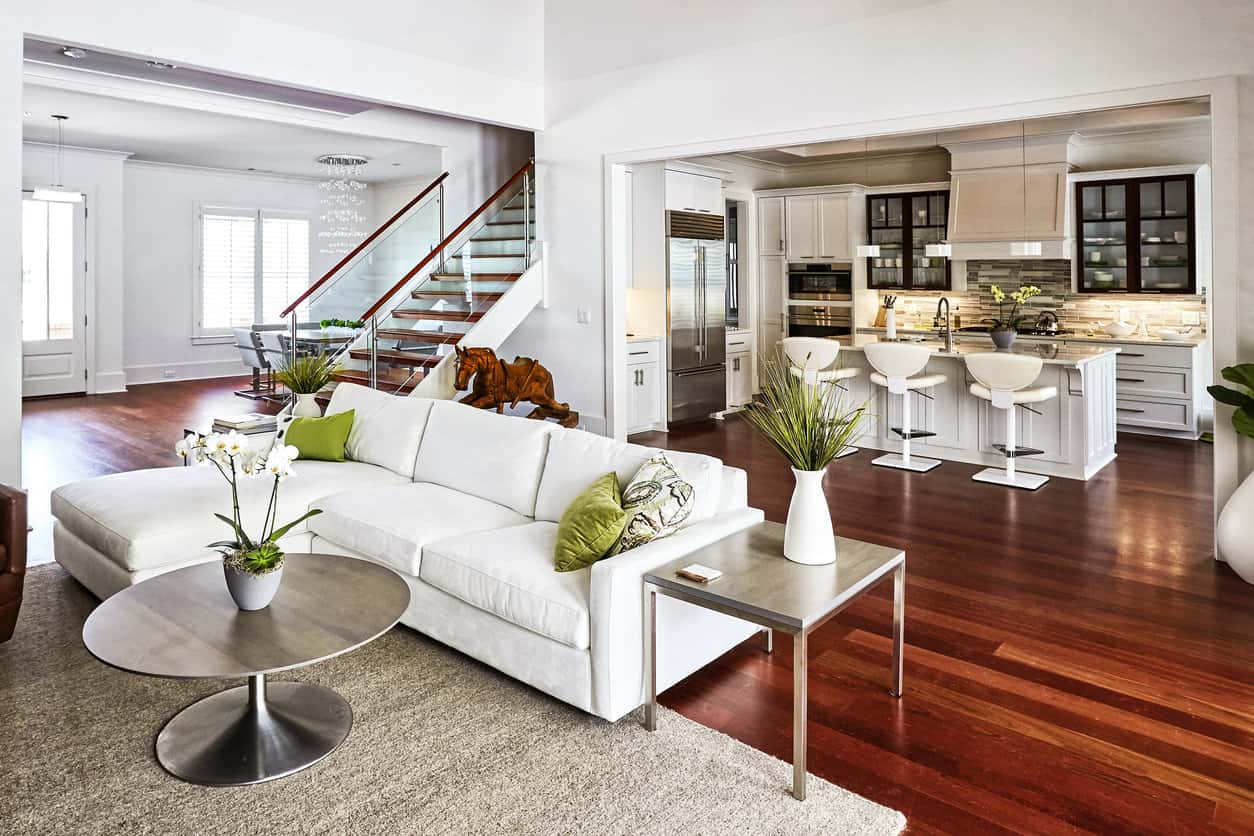Kitchen-Living Room Fusion: Layout Hacks for a Seamless Space
Kitchen-Living Room Fusion: Layout Hacks for a Seamless Space
The modern home is all about open-plan living, and for many, that means merging the kitchen and living room into one harmonious space. This can be a fantastic way to create a feeling of openness and flow, allowing for easy interaction and socialising. However, achieving a seamless layout that works both functionally and aesthetically can be a challenge.
This article explores the art of kitchen-living room fusion, offering practical layout tips and design strategies to help you create a space that is both beautiful and functional.
The Benefits of a Combined Kitchen-Living Room
Before diving into the layout specifics, let's explore the benefits of combining these two important spaces:
- Enhanced Social Interaction: A combined kitchen-living room fosters a natural flow of conversation. While preparing meals, you can easily chat with guests or family members relaxing in the living area. This creates a more inclusive and social atmosphere.
- Open and Airy Feeling: Eliminating walls between the kitchen and living room increases the feeling of space and light. This is especially beneficial in smaller homes, making the overall area appear larger.
- Flexibility and Multifunctionality: A fused space becomes more adaptable. It can be easily transformed for different purposes, from hosting dinner parties to creating a cozy reading nook.
- Cost-Effective: Combining spaces often means less renovation and less furniture needed, making it a budget-friendly approach.
Layout Planning Essentials
Now, let's delve into the layout considerations that are crucial for a successful kitchen-living room fusion:

-
Traffic Flow and Circulation:
-
Consider Your Needs: The layout should facilitate smooth movement throughout the space, ensuring easy access to all areas without feeling congested. Think about how you typically move within the space: from the entrance, around the kitchen, to the living area, and back again.
- Island or Peninsula: Consider adding an island or peninsula to create a distinct zone for cooking and prep while still maintaining visual connectivity.
- Clear Pathways: Maintain generous pathways between the kitchen and living room, at least 3-4 feet wide, to prevent bottlenecks and ensure comfortable passage.
- Avoid Furniture Blockages: Position furniture, especially large sofas or bulky storage units, strategically to allow for smooth movement.
-
Consider Multiple Entrances/Exits: If possible, design the layout with multiple entrances and exits to avoid unnecessary traffic flow through the kitchen.
-
Defining Zones:

- Kitchen Zone: Clearly define the kitchen area, whether it's with a counter overhang, different flooring, or distinct lighting.
- Living Room Zone: Create a cozy and inviting living room zone by incorporating a comfortable seating arrangement, a statement rug, and attractive décor.
-
Visual Separation: Use different flooring materials (wood in the living room, tile in the kitchen), paint colours (warm tones in the living room, cooler tones in the kitchen), ceiling heights (a drop ceiling in the kitchen), or architectural features like archways or beams to subtly separate the spaces.
-
Furniture Arrangement:
-
Open Concept Furniture: Choose furniture with an open concept design. For example, a sofa with low backrests or a coffee table with a glass top to minimize visual obstruction.
- Multifunctional Furniture: Invest in multifunctional furniture like a sofa bed, storage ottomans, or a console table that doubles as a bar counter. This maximises space utilisation and avoids clutter.
- Scale and Proportion: Carefully consider the scale and proportion of your furniture choices. Too much furniture can make the space feel cramped, while too little can leave it feeling empty.
- Visual Balance: Aim for visual balance by distributing the furniture across the space.

Design Strategies for a Seamless Look:
-
Colour Palette:
-
Harmonious Hues: Choose a harmonious colour palette for both spaces. This creates a sense of unity and flow.
- Transitional Colours: Use transitional colours to connect the kitchen and living room. For example, if your kitchen has white cabinets, consider a pale grey or light beige for the living room walls to provide a subtle connection.
- Statement Wall: A bold statement wall in one of the spaces can add a focal point and visually connect the two areas.

-
Materials and Finishes:
-
Consistent Materials: Use consistent materials throughout the space, like hardwood flooring, natural stone countertops, or stainless steel appliances, to create a cohesive look.
-
Texture and Pattern: Introduce texture and pattern through fabrics, rugs, and wall treatments. For example, a natural jute rug in the living room can complement a woven bamboo pendant light in the kitchen.
-
Lighting:
- Multiple Light Sources: Utilize multiple light sources to create ambience and highlight different areas.
- Task Lighting: Ensure adequate task lighting in the kitchen area for food preparation and cleaning.
- Ambient Lighting: Soft, ambient lighting in the living room creates a cozy and inviting atmosphere.
-
Dimmers: Incorporate dimmers to adjust the lighting intensity based on your needs.
-
Storage Solutions:
-
Maximise Storage: Invest in ample storage solutions, especially in the kitchen. This helps to keep the space organised and clutter-free.
- Hidden Storage: Utilise hidden storage solutions like cabinets with pull-out shelves, drawer dividers, or under-counter storage baskets to maximize space and maintain a sleek look.
Layout Ideas for Different Kitchen-Living Room Configurations:
-
Open Plan with Island:
-
This layout is ideal for larger spaces. The island acts as a natural separation between the kitchen and living room, providing extra countertop space, seating, and storage.
- Position the island strategically to create a defined cooking and prep area while maintaining visual connectivity with the living room.

-
Open Plan with Peninsula:
-
A peninsula is a smaller version of an island, typically attached to a wall. This layout offers a more compact separation between the kitchen and living room.
-
Use the peninsula as a breakfast bar, a casual dining spot, or additional counter space.
-
Open Plan with Bar Counter:

- A bar counter can be a stylish and practical way to separate the kitchen and living room.
-
It provides a functional space for entertaining, casual dining, or simply as a visual divider.
-
Open Plan with Furniture Placement:
-
Strategic furniture placement can effectively define separate zones without physical barriers.
- For example, position a sofa and coffee table in the living room area, creating a distinct focal point.
/neutral-living-room-white-fireplace-594af4cd-dfb9df1c2680468ab84c14d87b0b9eb9.jpg)
Additional Tips for a Successful Kitchen-Living Room Fusion:
- Choose Appliances Wisely: Select appliances that blend seamlessly with the overall design, such as integrated refrigerators, dishwashers, and ovens.
- Consider the Sound: If noise is a concern, use sound-absorbing materials like rugs, curtains, and acoustic panels to minimize kitchen noise from reaching the living area.
- Prioritize Comfort and Functionality: Ultimately, a successful kitchen-living room fusion should prioritize both comfort and functionality. Ensure that both areas are conducive to your lifestyle needs.
Conclusion:

Fusing your kitchen and living room can be a rewarding and transformative design project. By carefully planning the layout, incorporating smart design strategies, and selecting the right furniture and appliances, you can create a harmonious and functional space that reflects your unique style and enhances your everyday life.
Kitchen & Living Room: Layout Hacks for Small Spaces
In the realm of interior design, small spaces present a unique challenge: maximizing functionality while minimizing clutter. This is especially true for the kitchen and living room, which are often the heart of a home, serving as gathering spots for family and friends. Combining these two spaces can be a clever solution for maximizing space, but it requires careful planning and strategic layout to achieve a harmonious and functional environment.
This guide explores various layout hacks to seamlessly integrate your kitchen and living room in a small space, creating a welcoming and efficient area that serves both culinary and social needs.
Understanding the Layout Challenge
The key to success lies in understanding the distinct requirements of both the kitchen and living room.
-
Kitchen: The kitchen demands a functional work triangle, defined by the sink, refrigerator, and stovetop. This triangle should ideally measure between 4 and 26 feet for optimal efficiency. In a combined space, it is crucial to maintain a clear separation between the cooking zone and the living area to prevent food odors and fumes from permeating the living space.
-
Living Room: The living room prioritizes comfort and ease of movement. It needs ample seating for guests, comfortable lounging options, and ample space for activities like reading, watching television, or engaging in conversation.
Design Principles for Small Spaces
Before delving into specific layouts, it's essential to understand the fundamental design principles that enhance the functionality and visual appeal of small spaces:
-
Light and Space: Maximize natural light by utilizing large windows and strategically placing mirrors to reflect light. Avoid dark colors, which can make a small space feel cramped. Instead, opt for lighter colors and open layouts to create a sense of spaciousness.
-
Multifunctionality: Choose furniture that serves multiple purposes. Consider multifunctional furniture like sofa beds, coffee tables with storage, and ottomans with hidden compartments.
-
Vertical Space: Utilize vertical space effectively. Incorporate tall cabinets, floating shelves, and wall-mounted storage solutions to minimize clutter on the floor and create a sense of airiness.
-
Minimalism: Embracing minimalism involves prioritizing essential furniture and belongings, minimizing visual clutter. This allows for better flow and a less cramped feeling.
Kitchen & Living Room Layout Hacks
1. Open Plan Layout:
This popular layout involves removing walls to create a single, open space for both the kitchen and living room. It maximizes natural light and creates a sense of spaciousness. However, careful planning is crucial:
- Clearly Define Zones: While an open plan eliminates physical barriers, visually separating the kitchen and living room is essential. This can be achieved through different flooring materials, color schemes, or designated furniture groupings.
- Consider a Kitchen Island: A kitchen island can act as a natural separator between the two areas. Choose a design with seating or a breakfast bar to create a distinct dining area within the open plan.
2. L-Shaped Layout:
This layout is ideal for maximizing space in smaller homes. The kitchen is positioned in an L-shape, creating a defined area for cooking while leaving ample space for the living room.
- Strategic Appliance Placement: Position the refrigerator and oven on the same wall to maximize the space in the cooking area. Use the opposite wall for cabinetry and countertop space.
- Living Room Extension: Extend the living room space by positioning a sofa or lounge chairs perpendicular to the L-shaped kitchen. This creates a natural visual separation and provides a dedicated relaxation area.
3. Linear Layout:
The linear layout arranges the kitchen and living room in a straight line. This is a simple and functional layout, particularly for narrow spaces.
- Maximize Counter Space: Utilize the entire length of the kitchen wall for countertop space and cabinetry. This creates a spacious work area without compromising the living room space.
- Floating Furniture: Employ floating furniture like a sofa positioned against the wall to visually extend the living room while minimizing clutter.
4. U-Shaped Layout:

This layout utilizes three walls to create a U-shaped kitchen, leaving a spacious central area for the living room.
- Centralized Work Area: The U-shaped configuration provides ample countertop space and creates a central work area within the kitchen.
- Open Living Room: The open space in the center of the U-shaped kitchen allows for ample room for furniture and activity in the living room.
5. Peninsula Layout:

The peninsula layout features a counter extending from the kitchen, creating a partial wall between the kitchen and living room.
- Defined Cooking Area: The peninsula creates a distinct separation between the cooking zone and the living area, while still maintaining a sense of openness.
- Multifunctional Counter: The peninsula can be used as additional countertop space, a breakfast bar, or even a casual dining area.
Tips for Combining Kitchens & Living Rooms

1. Visual Separation:
Even in an open plan layout, visually defining the kitchen and living room is essential. This can be achieved through:
- Different Flooring Materials: Use distinct flooring materials like hardwood for the living room and tile for the kitchen to create visual separation.
- Color Schemes: Opt for contrasting color palettes for each area. For example, use neutral tones for the living room and bright accents for the kitchen.
- Furniture Placement: Strategically place furniture to delineate the spaces. Position a sofa or a rug to create a visual barrier between the living room and the kitchen.

2. Storage Solutions:
Maximizing storage is crucial in small spaces. Employ these strategies:
- Wall-Mounted Shelves: Utilize wall space for floating shelves to create visual interest and store items like dishes, glassware, or books.
- Under-Cabinet Storage: Install under-cabinet organizers to maximize vertical space and keep kitchen essentials within reach.
- Hidden Storage: Utilize hidden storage solutions like ottomans with compartments or coffee tables with drawers to keep clutter concealed.
3. Lighting Strategies:
Strategic lighting can dramatically affect the feel of a small space:
- Layered Lighting: Utilize a combination of ambient, task, and accent lighting to create a balanced and functional environment.
- Natural Light: Maximize natural light by utilizing large windows, skylights, or glass doors.
- Under-Cabinet Lighting: Install under-cabinet lighting in the kitchen to illuminate the work area and create a warm ambiance.

4. Furniture Selection:
Choose multifunctional furniture to maximize space and add versatility:
- Sofa Beds: Opt for a sofa bed to provide additional sleeping space for guests.
- Coffee Tables with Storage: Select a coffee table with built-in storage for books, magazines, or remote controls.
- Ottomans with Hidden Compartments: Utilize ottomans with hidden compartments to store blankets, pillows, or other items.

5. Color Palette:
The color palette you choose can drastically impact the visual perception of your space.
- Light and Bright: Opt for light and bright colors for walls, furniture, and accessories to create a sense of spaciousness and airiness.
- Neutral Tones: Use neutral tones as the primary color scheme and add pops of color through accessories and artwork to add visual interest.

6. Reflect Natural Light:
Mirrors can effectively enhance the perception of space by reflecting light. Strategically place mirrors near windows or opposite light sources to maximize the effect.
7. Embrace Minimalism:
/neutral-living-room-white-fireplace-594af4cd-dfb9df1c2680468ab84c14d87b0b9eb9.jpg)
Minimalism focuses on decluttering and creating a clean and uncluttered space. This approach can be particularly effective in small spaces:
- Prioritize Essentials: Only keep essential items in the kitchen and living room.
- Declutter Regularly: Make a conscious effort to declutter regularly to avoid excessive clutter.
Conclusion

Combining your kitchen and living room in a small space requires careful planning and attention to detail. By utilizing the layout hacks, design principles, and tips discussed in this guide, you can create a welcoming and efficient environment that optimizes space and serves both culinary and social needs. Remember, the key is to prioritize functionality, embrace minimalism, and create a cohesive and visually appealing space that reflects your individual style. .
